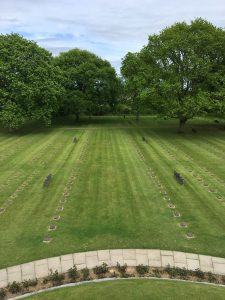We are now in Berlin, our final destination. I first want to reflect on the immense amount of historical information I have received along this trip. From the British People’s War and France’s universal perception, to Poland’s unique experience as the Bloodlands on a different front, we have learned new narratives about a war we collectively find interesting to study. I have learned new ways of approaching and viewing events, agendas, and controversies. No two societies approached the war or its aftermath in similar fashions. Belonging to Fortress America can make this perception hard to understand, making trips like this that much more important. I am thankful beyond expression for having this opportunity.
Personally, Berlin has offered the most foreign theme of all our destinations. Not because they speak a different language. They actually speak good English. It also is not the culture. Berlin is a very young and international city. It is very inviting and safe. Instead, The German World War II theme departs the furthest from the American theme. In the aftermath of WWII, the Germans had multiple problems. First, they had lost the war. A defeated society loses agency over its historical narrative, and this is obvious across the city. We visited the Soviet War memorial, where the fallen Soviets are commemorated, and an entire walkway displays the united proletariat rising to defeat National Socialism (Nazism). The hammer and sickle is featured in every obelisk and stone structure. Likewise, the Soviet star follows you along the walkway toward the mass burial grave, which is topped with a Soviet man beheading a Swastika. Clearly the Germans had little say over this memorial.
Germany also had to find its own narrative of the war. Germany had to recreate a national identity without bashing themselves. This is apparent in the Reichstag, or the parliament building. The original walls with Soviet transcriptions remain exposed in a handful of places. Architect Norman Foster believed exposing the writings, some of which say “Stalingrad to Berlin” and “Long Live Stalin,” would help remind and infuse a horrible chapter of German history into their modern version of democracy. The German government accepted this proposal, creating an exhibition on what happened in 1945 Berlin. Constant bombing from planes and artillery and street-by-street fighting destroyed large swaths of Berlin, and the Reichstag was not excluded. Including this painful reminder of the Battle of Berlin and subsequent partitioning. Germany was not united until 1990.
They also had to accept their role in the Holocaust and other atrocities. They had to balance an accepting/analytical approach without denying/excusing their actions. Places like the Topography of Terror museum, which is located at Hitler’s SS police headquarters, described what happened in the cellblocks underneath the building. It explained the discriminate process SS officials used to lock up Jews. It explained how German civilians used the SS to remove rival shop owners, annoying neighbors, or unpopular colleagues. The museum held nothing back. It described a wave of terror without interjecting an excuse. It worked the SS into a story of shame and embarrassment. It also worked it into a story of right and wrong, and lessons learned. This created a narrative explaining the horrible facts of the Nazis while dictating the lessons Germany, and the world, had learned from the era.
Everywhere you look, you see the remnants of a terrible war. From the Soviet war memorials, to the Capitulation museum, to the language used at modern museums, Germany has taken a new tone to its past. Destruction of WWII Berlin allowed the city, along with the nation, to redesign its image. Germany has found a way to be proud of who they are, and apologize about their past.
Finally, I cannot believe this trip is complete. It has been a wild ride. Our group of 23 Buckeye students came together, forging bonds that will last a lifetime. We truly are a band of brothers and sisters. I cannot wait to see how future groups enjoy their time abroad.
Prost!

















